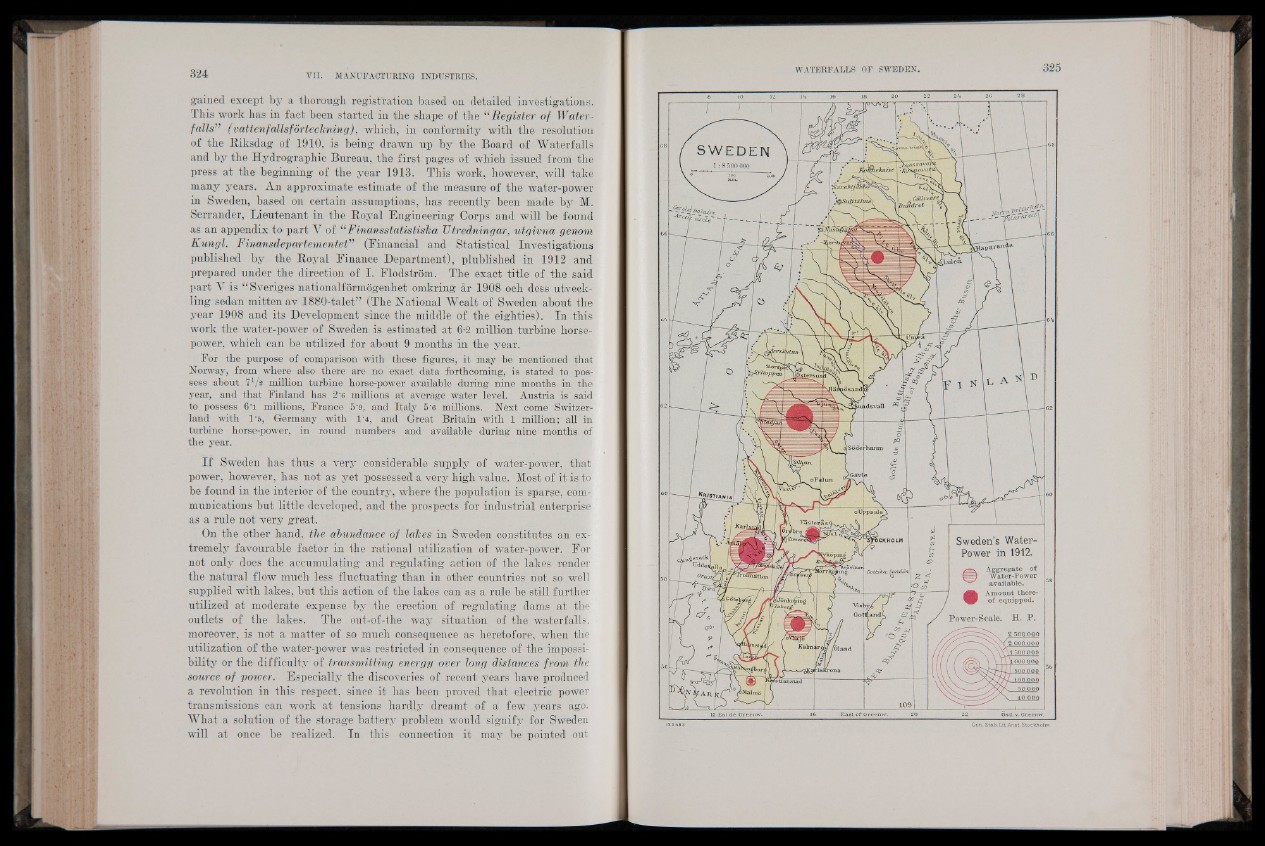
gained except by a thorough registration based on detailed investigations.
This work has in fact been started in the shape of the “Register of Waterfalls”
(vattenfallsforteckning), which, in conformity with the resolution
of the Riksdag of 1910, is being drawn up by the Board of Waterfalls
and by the Hydrographic Bureau, the first pages of which issued from the
press at the beginning of the year 1913. This work, however, will take
many years. An approximate estimate of the measure of the water-power
in Sweden, based on certain assumptions, has recently been made by M.
Serrander, Lieutenant in the Royal Engineering Corps and will be found
as an appendix to part Y of “Finansstatistiska Utredningar, utgivna genom
Kungl. Finansdepartementet” (Financial and Statistical Investigations
published by the Royal Finance Department), plublished in 1912 and
prepared under the direction of I. Flodstrom. The exact title of the said
part Y is “ Sveriges nationalformogenhet omkring ar 1908 och dess utveck-
ling sedan mitten av 1880-talet” (The National Wealt of Sweden about the
year 1908 and its Development since the middle of the eighties). In this
work the water-power of Sweden is estimated at 6-2 million turbine horsepower,
which can be utilized for about 9 months in the year.
For the purpose of comparison with these figures, it may be mentioned that
Norway, from where also there are no exact data forthcoming, is stated to possess
about fI1/2 million turbine horse-power available during nine months in the
year, and that Finland has 2‘6 millions at average water level. Austria is said
to possess 6'i millions, France 5'9, and Italy 5-6 millions. Next come Switzerland
with l ’fi, Germany with 1'4, and Great Britain with 1 million; all in
turbine horse-power, in round numbers and available during nine months of
the year.
I f Sweden has thus a very considerable supply of water-power, that
power, however, has not as yet possessed a very high value. Most of it is to
be found in the interior of the country, where the population is sparge, communications
but little developed, and the prospects for industrial enterprise
as a rule not very great.
On the other hand, the abundance of lakes in Sweden constitutes an extremely
favourable factor in the rational utilization of water-power. For
not only does the accumulating and regulating action of the lakes render
the natural flow much less fluctuating than in other countries not. so well
supplied with lakes, but this action of the lakes can as a rule be still further
utilized at moderate expense bjr the erection of regulating dams at the
outlets of the lakes. The out-of-the way situation of the waterfalls,
moreover, is not a matter of so much consequence as heretofore, when the
utilization of the water-power was restricted in consequence of the impossibility
or the difficulty of transmitting energy over long distances from the
source of power. Especially the discoveries of recent years have produced
a revolution in this respect, since it has been proved that electric power
transmissions can work at tensions hardly dreamt of a few years ago.
What a solution of the storage battery problem would signify for Sweden
will at once be realized. In this connection it may be pointed out
I cknise !vitra>
! ^arektj棏--
j$Sulitä2m a\ .Gäüiv
I D iif id r e t
"esitutan
i^Syltoppt iö s te r si
idsvaH
¡VVxsvt<
lÒWbro WjäXmor« Sweden’s Water-
jy k ö pm g Power in 1912.
Aggregate of
Water-Power
available.
Amount thereof
equipped.
TroHhättan
WÖnköpini r . ) . x
Power-Scale. H. P.
Kabn; Voland
fstìan slad